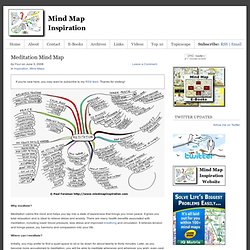

Get It Out of Your Mind And Into a Mind Map - by Gina Hiatt Ph.d. Author: Gina Hiatt Ph.d.

Do you ever feel like you have some great ideas, but when you sit down to write them, they're not so great? Or even worse, you can't really get a sense of what the ideas were? In one of my graduate student coaching groups we have been discussing the difficulty of translating partly formed ideas into words on paper.
One technique that makes use of a normally underutilized part of our brain is called "Mind Mapping. " What is a Mind Map? Tony Buzan, who created the word "Mind Map" and has written extensively on it, describes it as a powerful graphic technique that makes use of the way our brains naturally work. 1. 2. 3. 4. How Do You Mind Map? Mind mapping is best done in color. Start with the central idea that you are trying to wrap your mind around. There are no rules for the way to proceed from here. Tony Buzan likes to draw curved lines emanating from the center, and write the related or associated ideas on the lines.
Meditation Mind Map. If you're new here, you may want to subscribe to my RSS feed.

Thanks for visiting! Why meditate? Meditation calms the mind and helps you tap into a state of awareness that brings you inner peace. It gives you total relaxation and is ideal to relieve stress and anxiety. There are many health benefits associated with meditation, including lower blood pressure, less stress and improved breathing and circulation. Where can I meditate? Initially, you may prefer to find a quiet space to sit or lie down for about twenty to thirty minutes. How to meditate Ideal times to meditate are on awaking and prior to sleeping. Sit with a straight back or lie down whichever feels more comfortable. Close your eyes and slowly start to let go of everything. The only energy you need is an awareness that stops you falling asleep or day-dreaming! Articles on mind mapping. Mind Tools Newsletter archive. The Mind Mapping Resource Center.
Blog – Amen Clinics. Faith – Intense Pain Went Away Dear Dr.

Amen, I have been thinking of writing this review for months! I want to share with people how effectual both of the above products were for me. Last year (2014) started for me with my mom in hospice care. Then my precious and beloved husband was suddenly killed in a car accident, delivering […] Keep Reading Proven Outcomes from New York – Anxiety & Depression Keep Reading Proven Outcomes from New York – Brain Injury Keep Reading 14 Warning Signs Your Brain Is In Trouble and What You Can Do to Eliminate Them Your brain will tell you it is in trouble, if you are listening.
Keep Reading Brain Reflections on the Ashley Madison Database Scandal The fallout won’t be measured in months, but in decades! Keep Reading Simple Strategies to Laser in Your Focus Did you know that you have your very own CEO inside of you? Keep Reading Back to School Distractions for Those with ADD Keep Reading The Mother of Perpetual Worry – Type 7 of 7: Anxious ADD. INTERAURA - HYPNOSIS PROGRAMS FOR LIFE. Get Inside Your Head: How Knowledge of Your Brain Can Make You a Better Leader : The World. Brain Map. Robert P.

Lehr Jr., Ph.D. Professor Emeritus, Department of Anatomy, School of Medicine, Southern Illinois University Español Brain Function and Deficits In traumatic brain injury the brain may be injured in a specific location or the injury may be diffused to many different parts of the brain. The brain has many parts including the cerebral cortex, brain stem, and cerebellum. Frontal Lobes: Most anterior, right under the forehead. Functions How we know what we are doing within our environment (Consciousness) How we initiate activity in response to our environment Judgments we make about what occurs in our daily activities Controls our emotional response Controls our expressive language Assigns meaning to the words we choose Involves word associations Memory for habits and motor activities Observed Problems Parietal Lobes: near the back and top of the head.
Occipital Lobes: Most posterior, at the back of the head. Vision.